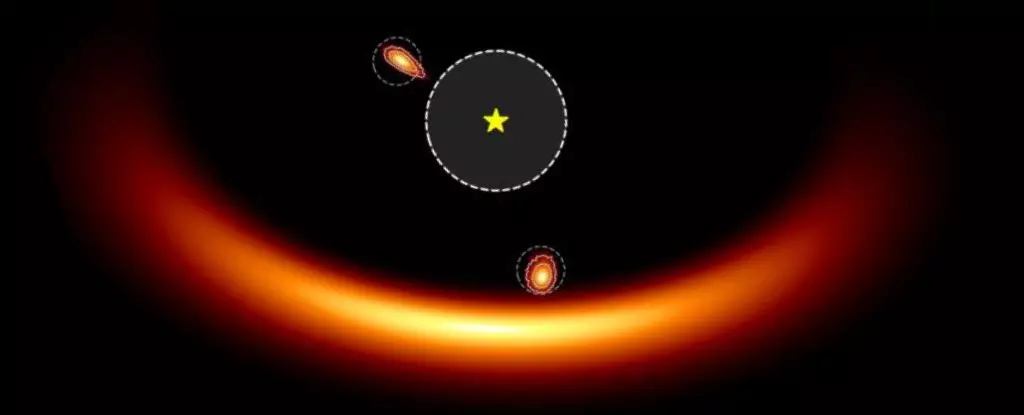The process of planet formation is among the most captivating and complex phenomena in astrophysics. It takes place in the swirling disks of gas and dust that envelop young stars. As researchers strive to decode this intricate process, the James Webb Space Telescope (JWST) has emerged as a pivotal tool, with one of its primary objectives being the study of planetary formation. One particularly interesting star system just a few hundred light-years away is PDS 70, which has garnered attention for its two directly imaged planets, PDS 70b and PDS 70c. These young celestial bodies offer an unparalleled glimpse into the early stages of planetary development.
Located approximately 370 light-years from Earth, PDS 70 is an orange dwarf star that is significantly younger than our Sun, estimated to be only about 5.4 million years old. Despite its youth, this star system is teeming with activity, as it is actively accreting material from its surrounding disk. PDS 70b and PDS 70c, the two protoplanets in this system, are of immense interest to astronomers for their potential to illuminate the dynamics of planet formation.
Evidence supporting the existence of PDS 70b and PDS 70c was first provided by the European Southern Observatory’s Very Large Telescope (VLT) in 2018, utilizing its innovative SPHERE instrument. Remarkably, PDS 70b holds the honor of being the first protoplanet ever imaged directly, marking a significant milestone in the field of exoplanetary studies. These direct observations allowed astronomers to gather valuable data regarding the planets’ atmospheres, masses, and temperatures, establishing a baseline for future investigations.
The JWST recently took its turn to scrutinize the PDS 70 system, utilizing its Near Infrared Imager and Slitless Spectrograph (NIRISS). The paper detailing these findings, authored by graduate student Dori Blakely and collaborators, provides groundbreaking insights into the planets’ formation processes. The team employed a technique known as Aperture Masking Interferometry (AMI). This methodology enhances the telescope’s resolution, allowing a clearer view of even the faintest signals in a complex system.
In these recent observations, the researchers uncovered intriguing evidence of material surrounding PDS 70b and PDS 70c, reinforcing the notion that the planets are in the midst of formation. This discovery is likened to capturing a snapshot of our Solar System in its infancy, revealing a cosmic family portrait of sorts. This analogy is not just poetic; it highlights how thorough studies of distant systems can broaden our understanding of our own Solar System’s history.
By observing PDS 70 at longer wavelengths than previous studies, the JWST provided new insights into the light emissions coming from the planets. The discoveries hinted at the presence of warmer material in the vicinity of both planets, suggesting that they are drawing in material from a circumplanetary disk. This accretion process is crucial, as it is directly linked to planetary growth and development.
The research indicates that both PDS 70b and PDS 70c are competing for the same resources within the circumstellar environment, a dynamic pertinent to understanding the evolution of planetary systems. The study’s analysis proposes that these planets are not isolated entities, but rather participants in a competitive framework where material availability directly influences their growth trajectories.
An exciting aspect of the new research is the suggestion of a potential third planet, provisionally named PDS 70d. Previous indications of this third body were met with some skepticism due to uncertainties in its characterization. However, the findings from the current JWST observations offer more clarity on the object’s properties, which may indeed point to the existence of a third planet. If confirmed, this body would likely exhibit a different atmospheric composition from its siblings, broadening the spectrum of planetary characteristics within this star system.
The PDS 70 system has become a key focal point for astrophysicists studying the processes of planetary formation. By utilizing advanced technologies such as the JWST and the VLT, researchers are able to peer into the past of our own Solar System while simultaneously enhancing our understanding of how planetary systems form and evolve across the cosmos. Each observation brings us closer to answering profound questions about the nature of planetary formation, paving the way for future explorations of the vast universe filled with uncharted celestial bodies. The enthralling journey into the formation of PDS 70 and its planets represents only the beginning of what the JWST may uncover, shedding light on the fundamental processes that govern the birth of worlds.


Leave a Reply